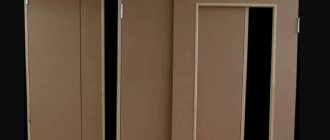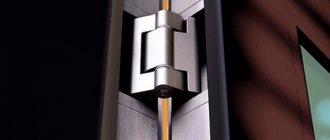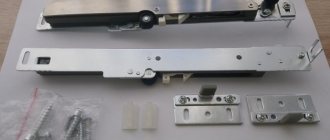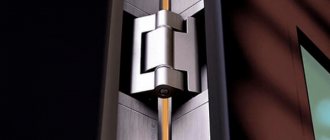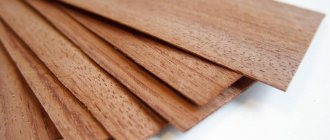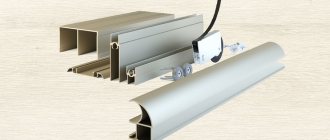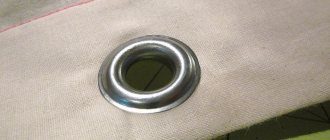The metal entrance door simultaneously serves as a protective enclosing structure that prevents unauthorized persons from entering the room, as well as an interior detail of the hallway, vestibule or hall. When installing the front door, the master demonstrates its ideal performance. However, during operation, the door may sag or become deformed due to temperature changes. In such situations, you need to know how to adjust a metal entrance door.
In what cases does a metal entrance door require adjustment?
The metal entrance door to an apartment or private house requires adjustment if any of the following situations occur:
- If creaking, crackling or other unpleasant sounds occur when the door is moved.
- If an uneven gap forms between the door leaf and the frame, the presence of which is determined by the user by a strong draft.
- If difficulties arise, if there is a bump, or if the door simply moves tightly while closing, which indicates a misalignment.
If the user identifies at least one of the defects described above, this indicates a malfunction of the door leaf and the need for urgent adjustment. If this requirement is neglected, negative consequences may occur, which will lead to the need to replace the door leaf along with the hinge mechanisms.
Required Tools
To repair the canvas you will need a small set of tools. To adjust the entrance metal swing door with your own hands you need:
- sealing rubber;
- screwdriver;
- socket wrench;
- hexagon;
- file.
Basically, all problems are related to sagging of the sash. They are often solved with a single key. The main thing is to know how to debug correctly. Oil is useful to eliminate friction and squeaks.
What's the best way to eliminate a squeak?
If the hinges begin to creak when closing, this indicates an increased friction force between two metal surfaces, or one of the end parts of the canvas is touching or tightly adjacent to the box. To resolve this issue, it is recommended to perform the following steps:
- The door leaf is removed from the hinges and laid on a horizontal plane. Considering that entrance enclosing structures, as a rule, have a large dead weight, it is recommended that two people do this work.
- The places of hinge joints on the hinge hangers are inspected.
- If dirt is detected, it is removed using a brush with stiff bristles.
- After the surface is cleaned, each hinge is wiped from the inside. If there is a thin hole, it is recommended to purchase a special cleaning rod from a hardware store.
- After cleaning, it is recommended to wipe the hinges on the canvas and box with a damp rag.
- As a rule, metal door leaves are equipped with ball bearings, which are also recommended to be removed from the rod and washed under running water.
- All wet metal surfaces must be dried. The bearing is lowered into a container with a viscous lubricant, after which the same substance is pushed in a small amount into the cavity for the hinge mechanism rod.
- The rod itself is lubricated with liquid mineral or synthetic machine oil.
- The door is carefully placed on the hinges, after which it must be developed by periodically opening and closing. This procedure must be repeated at least 5 - 10 times, until the blade begins to rotate with one press.
If the blade touches the bottom edge of the box, it is recommended to place a steel washer with a thickness of at least 1 mm between the bearing and the hinge. In such cases, the door rises exactly this amount and, as a rule, stops touching the frame.
If you do not have a viscous lubricant on hand for machine parts and mechanisms, the best solution is to use a penetrating lubricant with a spray bottle, which is effectively sprayed over the entire contact plane. The disadvantage of this substance is its rapid abrasion, which leads to the need to repeat the procedure after 1 - 2 years.
If the hinges of a metal entrance door in a private house that faces the street are to be treated, when purchasing lubricants, you must carefully study the instructions for their use, as well as the characteristics and composition. The substance should not disintegrate and freeze at subzero temperatures in winter.
Formation of a gap
Has free space appeared between the frame and the canvas itself? With an unprofessional eye, such a defect may not be noticed, but it is felt very quickly. You can feel the presence of cracks on yourself by the draft. There are several reasons for gaps:
- A seal that has become unusable. It is necessary to replace the rubber rubber and adjust the entrance door. All this should not cause difficulties. It is enough to remove the old material, clean the area, treat it with a degreaser, and then glue a new tape. You should first check how the canvas stands. This is due to the fact that high rubber wear can be caused by misalignment.
- Sagging of the canvas. This is another reason why gaps may appear. To eliminate it, you will need to adjust the front door hinges. For this purpose, the fasteners of both canopies are screwed in/unscrewed. Here you need to keep in mind that their movement along the axis has a limit. In view of this, when the hinges are worn to the maximum extent, a washer or groover should be provided under the fasteners.
Specific actions depend on the design features of the loops, as well as on the current situation. It may make sense for you to replace one or more hinges and then think about adjusting your front door.
How to properly eliminate friction between the canvas and the box
If the leaf rubs and touches the door frame when closing, this indicates sagging of a heavy product during operation, or significant temperature changes. Depending on the nature of the problem, experts recommend doing the following:
- The door structure is inspected to determine where the door leaf touches the frame.
- If a problem occurs at the junction of the locking element or the tongue of the twist lock to the vertical post of the opening frame, this problem can be eliminated by adjusting the position of the device's bolt.
- If there is deformation of the lock tongue response plate, it is necessary to straighten it to its previous position by hitting it with a hammer and then restoring the paint layer.
- If the door has hidden hinges, they can be easily adjusted by turning a few screws on their inner surface with the door leaf open.
This action is performed by slowly turning a slotted or Phillips screwdriver.
Each screw is responsible for moving the blade several millimeters in the longitudinal or transverse direction.
Some adjusting screws, especially on Chinese-made doors, are equipped with internal hexagon heads, which requires an appropriate L-shaped wrench with the required head size.
- If the door is mounted using standard cylindrical hinges, it is easily lifted, removed from the hangers, and a pre-oiled flat steel washer is placed under the bearings.
- Modern hinges are also equipped with a lifting mechanism with a threaded drive. These products have a screw in the inner lower part with a head for an internal hexagon or an asterisk key.
When installing the appropriate tool and turning it, the screw raises the blade or lowers it, depending on the direction of rotation.
- If there is a decorative plastic cover on the hinge that blocks access to the screw head, it can be easily removed using a chisel with a thin and sharp edge, or a construction knife with a retractable blade.
- When adjusting the hinges, taking into account the sensitivity of the screws, it is recommended that after each rotation of the hardware by 180 degrees, check the movement of the blade on the hangers.
It should be noted that any subsidence of the canvas indicates deformation of the hinges or their welded connection to the box material. When performing simple adjustments, the problem may occur again after a certain time. This will lead to the fact that after a few years the owner of the premises will have to re-weld the hinges, or replace the entire door leaf along with the frame.
tight narthex
Basically, such a defect occurs for two reasons. Let's look at how to adjust a metal door separately for each specific case:
Large seal thickness . Entrance doors must be equipped with a special rubber band that seals the seams and closes the gap between the door leaf and the frame. Most often, owners of new, recently installed doors face the problem of a tight shutter. The fact is that the rubber band has not yet had time to spread, and therefore can complicate closing the door. The rational solution is to wait; over time, the seal will develop, shrink slightly, and the problem will solve itself. Under no circumstances should you cut the elastic, because after a few weeks it will sag and a gap may appear in that place.
A tight seal may be caused by a new seal that has not yet been developed
Mismatch between the position of the tongue and the plate . In this case, the locking mechanism touches the plate and has difficulty moving into the recess. This defect is not uncommon for cheap models; the problem can be solved with the help of a file. You need to carefully grind off the excess metal on the plate so that the tongue fits freely inside, but at the same time securely holds the door in the closed position. If the metal can be bent, try straightening the tendrils using pliers.
The problem may arise in the area of the locking mechanism
How to fix the blowing problem
Blowing through a metal entrance door is one of the most common problems that can arise during its operation. If there is a draft in an apartment or private house, the user recommends following all the points of the following flow chart:
- To solve this problem, an integrated approach is required, since blowing can appear from several places at once.
- The door leaf is removed from the hinges and laid with the inner plane facing up.
- Using a screwdriver or chisel, clean the seam between the frame and the wall trim on both sides.
- The gap is cleared of dust.
- Decorative plastic plugs (if any) are removed from the racks, lintel and threshold of the box to free access to the anchors.
- The anchors are carefully unscrewed, which is why the box receives a small degree of freedom.
- Silicone or acrylic sealant is applied into the resulting gap using a dispenser gun.
- Polyurethane foam is injected into the holes for the anchors until the substance begins to come out through other holes.
- After hardening, the remaining foam is carefully cut off with a construction knife.
- The anchor nuts are re-screwed onto the threaded rods of the anchors.
- The master checks the vertical position of the door frame and the consistency of its position using a building level.
- Polymer tubular seals are installed along the perimeter of the door leaf rebate, which compress when pressed. This tape is sold in any hardware store and is equipped with a protective film, under which there is an adhesive compound.
- The door leaf is hung back on the hinges.
- At the final stage, the normal opening of the door leaf is checked, after which it can be operated in normal mode, and the draft, in most cases, disappears.
- If the door is mounted without the use of anchors, on steel eyes, the owner of the premises will have to resort to capital measures. They consist in finishing the slopes from special thin energy-efficient sandwich panels. This work requires special tools and skills, and also involves wet processes, so the best solution would be to turn to professionals who will perform all operations quickly, efficiently, and then provide a long-term guarantee for the result.
If this problem is neglected, during the cold season, the property owner may incur unjustified costs for paying for energy resources, since the energy efficiency of the premises is lost.
Getting rid of dust
Dust often clogs door hinges, and they begin to creak loudly. Moreover, dust most often gets there during repair work.
Adjusting the hinges on the front door
The solution to this problem is quite easy - the hinges are blown through with air under pressure and then lubricated.
Not all products are lubricants - a prime example of this is a product like WD, which removes only traces of “boiling” that form on threaded and swivel joints.
Photo gallery of lubricants for door hinges
How to fix a sagging door
The entrance door to a residential or non-residential premises, most often, has an increased dead weight. In this regard, the situation with its sagging due to the gradual deformation of loop suspensions is not uncommon. To fix this problem, you need to follow these simple steps:
- Replacing loop hangers:
- It is used when door hinges cannot be repaired due to too much physical wear, or if they were not originally designed for a door leaf with a given weight.
- The door leaf is removed from the hinges and laid on a horizontal plane.
- Finishing elements on the door and frame, as well as around the slopes, are covered with protective materials.
- The loops are cut using a grinder on which an abrasive disc is installed.
- The cut area is cleaned with a file, after which it is polished with disk attachments on a drill with various abrasives until a smooth steel surface is achieved.
- New cylindrical hinges with bearings are purchased at the store.
- The products are applied to the door and secured by welding.
- The master checks the correct position of the products, and then straightens them, if necessary, using a hammer.
- When the loops are in the desired position, the master welds the joints throughout the entire example.
- After welding, the seam area is cleaned and thoroughly polished.
- At the final stage, the paint layer in the place where the welding machine operates is restored.
- To replace hidden doors, it is enough to unscrew the hardware from the old products with a screwdriver, then mount new hinges and tighten the self-tapping screws or screws until they stop.
- Replacing ball bearings:
- This operation is ordinary and does not require the involvement of specialists.
- The door leaf is removed from the hinges, after which the ball bearings are removed from each pin.
- If the product does not yield due to irreversible deformations, the craftsman must pick it up around the perimeter with a chisel, or tap along the entire contour of the bearing with a hammer.
- After removal, it is necessary to check the outer and inner diameters of the part, as well as their thickness, so as not to make a mistake in the dimensions when purchasing parts.
- New bearings are lubricated with a viscous substance or grease.
- The bearing is put on the pin of each loop, after which the blade again takes its design position.
- The seams between the bearings and hinges are treated with penetrating lubricant, and the master develops the restored mechanism by repeatedly opening and closing the door.
- Installation of spacer washers:
- This action is necessary to adjust the height of the door if it accidentally subsides over time.
- The magnitude and approximate amplitude of the drawdown are determined.
- The canvas is removed from the pins.
- The master measures the diameter of the rod, as well as the outer dimensions of the cylindrical loop itself.
- Washers are purchased with a thickness that is 0.5 - 1.0 mm greater than the subsidence amplitude of the door leaf.
- Disc steel spacers are lubricated in grease and then placed under the bearings on the rods.
- The canvas is installed on loop hangers and its normal closing is checked, without touching the box.
- If it is impossible to select the required washer, it is necessary to make a sketch drawing of the part and order it from a turning workshop, according to the technical specifications.
- Repair and adjustment of hinges:
- For this work, it is necessary to make sure that the hinges are truly recoverable.
- The door is removed from the hangers.
- The master adjusts the position of the suspensions by rotating different straightening screws.
- Next, it is necessary to examine the condition of the hinges and identify possible deformations.
- The rods or plates are adjusted by repeated blows of a hammer while monitoring the desired position using a building level.
- When the work is completed, the master inspects the absence of breaks or cracks, after which the door leaf is installed in place and its correct opening is checked.
The problem depends on each specific situation, and before making a decision to eliminate it, the owner of an apartment or private house is recommended to inspect the condition of the hinge mechanisms, and then select the desired repair method.
Hidden
They are called 3D loops. Hidden loops are distinguished into:
- Adjustable;
- Unregulated.
To repair an adjustable hidden hinge:
- Remove all covers hiding the screws;
- Using the key that comes with the hinge, loosen the necessary screws to align the door height, along the gap between the door frame or horizontally;
- Align the door;
- Secure the door leaf by screwing the screws back.
The instructions for hidden hinges contain an illustration of the rules of use. It clearly shows the bolts and what parameter of the door they are aimed at regulating.
Non-adjustable hinges are made from strong materials and are distinguished by their reliability. But they are not subject to any type of adjustment. If a hidden non-adjustable hinge breaks, you must buy a new one.
How to perform preventative door adjustments without carrying out repair work
In some cases, the door leaf may slightly touch the threshold of the frame, but does not cause severe discomfort to the owners during operation. In such situations, it is recommended to carry out preventive straightening work, which consists of performing the following actions:
- Adjusting the hinges using a slotted screwdriver, a Phillips screwdriver, an asterisk wrench or an internal hexagon.
- When installing three hinges for a heavy sheet, the problem with snagging can be corrected if the master loosens the fastening of the middle hanger, which relieves longitudinal stress in the metal structure.
- If friction occurs in the upper (jumper) part of the box, the technician will need to lower it by adjusting the screw in the upper hinge hanger.
- If the lower part is touched (at the level of the threshold), it is necessary to adjust the loop suspension by raising the blade while turning the adjusting screw of the lower suspension.
- When all the hinges are loosened, the door leaf gains a little freedom, which allows the master to move it by 1 - 2 mm, followed by fixing the structure in a static position.
- Deformed hidden hinges, when the screws are loosened, may return to their previous position; when moving the door leaf, this operation should be performed carefully to prevent deformation of the soft steel plates.
It is recommended to carry out door maintenance work at least once every 6-12 months, depending on the location of the door leaf installation. If the property owner uses the apartment door, then such a product will last longer.
If a door is installed in a cottage, it is subject to periodic temperature changes through zero, which promotes linear expansion and contraction. In such situations, loop mechanisms may be subject to corrosion and other negative environmental influences. Thus, it is recommended to service them once every 6 months, or at the slightest sign of malfunction.
It should also be taken into account that an all-steel door leaf installed outdoors may be subject to deformation in the summer, especially if it is painted in dark shades. The heating temperature of a metal surface in hot weather, under the influence of direct sunlight, can reach 40 degrees or more. This can lead to the fact that, regardless of the serviceability of the hinges, the lock tongue will not fit into the hole in the strike plate.
The described situations lead to negative consequences - the user is forced to slam the door hard, which leads to breakage of handles, locks, and deformation of hinges. To avoid such situations, it is recommended to order external doors only with linings made of porous materials - natural wood or MDF. The material will act as a heat-insulating structure, which will reduce the risk of overheating and deformation of the steel sheet or its supporting frame.
What to do after purchase?
So, you have purchased a door for your house or apartment. You are satisfied with the purchase. It meets your aesthetic taste, it is massive and is capable of protecting property from intruders. But, you don’t know that your door needs systematic care.
Incorrect actions or normal operation may interfere with the operation of the door or lead to its breakage. Let's try to solve this problem. In order to extend its service life, you need to perform periodic preventive actions.
In short, in order to keep it in working condition, you must do the following:
- it must be lubricated regularly;
- it is necessary to pay attention to its appearance;
- you must periodically tighten the working elements, as they quickly become loose (this includes fittings and hinges);
- it is necessary to clean the crossbars from dust at certain intervals;
- If necessary, it is worth changing insulation and seals.
Care
By following these simple and uncomplicated operations, you can significantly extend the life of your door and avoid the financial costs of troubleshooting. The main cause of failure is incorrect adjustment.
If it is adjusted incorrectly, this can lead to the following consequences:
- if it is adjusted incorrectly, the mechanical parts of the hinges wear out faster;
- improper adjustment can lead to sagging;
- Also, various types of breakdowns are possible, such as jamming of the lock (see How to open the front door without a key), etc.
